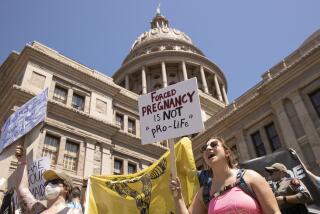Preemie Rate Highest in 20 Years, Report Says
- Share via
WASHINGTON — The percentage of babies born prematurely in the U.S. reached a two-decade high last year, driven by an increase in twins and triplets. The government also found a rise in prenatal care and a drop in smoking during pregnancy.
Births to teenagers fell for the 10th year in a row, with abortion on the decline too. At the same time, births to women in their 30s and 40s continued a steady climb, according to an annual review of birth statistics that was released Wednesday.
Overall, 4,025,933 babies were born in the United States in 2001, a small drop from 2000.
There were more boys than girls, by a tiny margin, and more births on Tuesdays than any other day. The most popular month to have a baby was August.
“It’s the winter months when people are holed up inside by a fire,” said Joyce Martin, the report’s lead author, offering one of several theories.
Not all the trends were positive. The percentage of Cesarean sections continued to climb, reaching nearly one-quarter of all births, the highest rate since data became available more than a decade ago. The rate has been on the rise for five years. Health officials have hoped to reduce the rate to 15%, contending that vaginal births carry a lower risk of medical complications for mothers. But the rates are climbing both for mothers who have never had a C-section before and for those who have.
Also disturbing: the rise in babies born prematurely, which is defined as less than 37 full weeks of gestation. The percentage of babies born that early rose to nearly 12%, the highest level since officials began tracking this category 20 years ago.
In a related finding, the portion of babies born dangerously small also rose, to 7.7% in 2001, an increase of 13% since the mid-1980s. Some of the rise for both factors can be traced to the increased number of multiple births; in these cases, babies tend to be born before their due date and smaller than other babies. Older mothers and women who use certain fertility treatments -- both of which are on the rise -- are more likely to have twins, triplets and even higher multiples.
The rise in prenatal care in the first trimester has been steady for a decade, particularly among Latinos and blacks.
In 2001, 83% of women got timely prenatal care, up from 76% in 1990. Black and Latino rates each rose from about 60% in 1985 to about 75% in 2001.
More good news: The portion of women who smoked while pregnant continued a decline that began more than 10 years ago, reaching 12% in 2001. The teenage birth rate hit another record low, the 10th year running it has fallen. Last year, there were 45.8 births for every 1,000 women age 15 to 19. Data reported separately show that the teenage abortion rate has fallen too.
More to Read
Sign up for Essential California
The most important California stories and recommendations in your inbox every morning.
You may occasionally receive promotional content from the Los Angeles Times.













